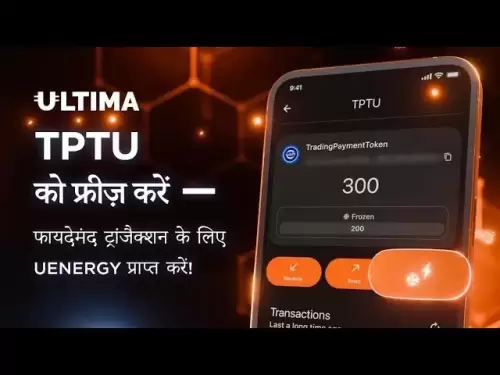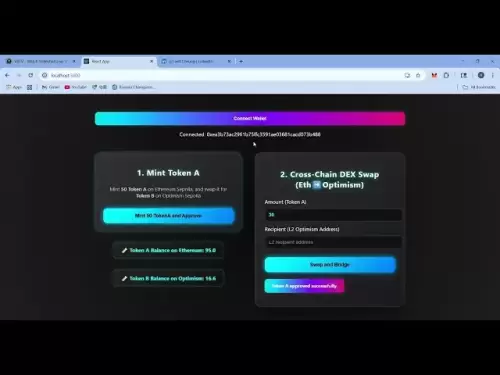-
 Bitcoin
Bitcoin $109,459.7682
2.44% -
 Ethereum
Ethereum $2,598.6052
6.29% -
 Tether USDt
Tether USDt $1.0003
0.00% -
 XRP
XRP $2.2734
3.95% -
 BNB
BNB $661.4886
1.58% -
 Solana
Solana $155.4825
4.35% -
 USDC
USDC $0.9999
-0.02% -
 TRON
TRON $0.2838
1.04% -
 Dogecoin
Dogecoin $0.1740
8.25% -
 Cardano
Cardano $0.6047
9.04% -
 Hyperliquid
Hyperliquid $40.2302
6.50% -
 Sui
Sui $2.9863
10.05% -
 Bitcoin Cash
Bitcoin Cash $509.5786
0.60% -
 Chainlink
Chainlink $13.8156
6.03% -
 UNUS SED LEO
UNUS SED LEO $9.0142
0.69% -
 Avalanche
Avalanche $19.0337
8.68% -
 Stellar
Stellar $0.2438
5.17% -
 Toncoin
Toncoin $2.9012
3.59% -
 Shiba Inu
Shiba Inu $0.0...01210
6.20% -
 Litecoin
Litecoin $90.0882
7.05% -
 Hedera
Hedera $0.1597
8.53% -
 Monero
Monero $326.3340
2.88% -
 Polkadot
Polkadot $3.6365
9.32% -
 Bitget Token
Bitget Token $4.6162
2.72% -
 Dai
Dai $1.0001
0.00% -
 Ethena USDe
Ethena USDe $1.0002
-0.01% -
 Uniswap
Uniswap $7.6403
10.47% -
 Pepe
Pepe $0.0...01060
12.03% -
 Aave
Aave $281.3664
7.56% -
 Pi
Pi $0.4992
1.76%
How to open a 75x contract on Gate.io
75x contracts on Gate.io amplify potential returns but demand high vigilance, requiring traders to employ leverage cautiously, monitor positions closely, and always prioritize self-education.
Nov 19, 2024 at 09:08 pm

How to Open a 75x Contract on Gate.io: A Comprehensive Guide
Introduction
Gate.io, a leading cryptocurrency exchange, offers a wide range of trading options, including perpetual contracts. Perpetual contracts are a type of derivative instrument that allows traders to speculate on the future price of an underlying asset, such as Bitcoin or Ethereum. With a 75x contract, traders can multiply their potential returns by up to 75 times their initial investment. However, it is crucial to understand the risks involved before entering into a 75x contract.
Step 1: Fund Your Account
To start trading 75x contracts on Gate.io, you need to fund your account. You can deposit cryptocurrency into your account or purchase cryptocurrencies using a credit card or bank transfer. Once your account is funded, you can start trading.
Step 2: Create an Order
To create an order for a 75x contract, you need to visit the "Contracts" tab on Gate.io. Then, select the asset you want to trade (e.g., BTC/USDT) and click on the "Create Order" button. In the order form, specify the contract type (e.g., Perpetual), the leverage (e.g., 75x), the order type (e.g., Limit Order or Market Order), and the amount you want to trade.
Step 3: Choose the Margin Mode
Gate.io offers two margin modes: Cross Margin and Isolated Margin. With Cross Margin, the entire balance of your futures account is used as collateral for your open positions. This means that if the market moves against you, your entire account balance could be at risk. With Isolated Margin, only the margin you specifically set for each position is used as collateral. This reduces the risk of losing your entire account balance.
Step 4: Set Your Leverage
The leverage is a multiplier that determines the amount of capital you can borrow from the exchange to increase your potential returns. However, it also amplifies your losses if the market moves against you. For example, if you set a leverage of 75x, you can borrow up to 75 times your initial investment. This means that if the price of the asset you are trading increases by 1%, your profit will be amplified by 75%. However, if the price of the asset decreases by 1%, your loss will also be amplified by 75%.
Step 5: Set Your Stop Loss
A stop loss is an order placed to automatically sell your position if the price of the asset reaches a certain level. This helps protect you from excessive losses if the market moves against you. To set a stop loss order, specify the price at which you want your order to trigger.
Step 6: Monitor Your Position
Once you have opened a 75x contract, you need to monitor your position closely. The risk of liquidation is especially high with such high leverage. If the market moves against you and your margin ratio drops below a certain level, your position may be liquidated. Liquidation means that the exchange will automatically sell your position to cover your losses.
Step 7: Close Your Position
When you are ready to close your position, you can do so by placing a closing order. To place a closing order, specify the amount of your position you want to close and the type of order (e.g., Market Order or Limit Order). Once your closing order is executed, your position will be closed.
Tips for Trading 75x Contracts
- Use leverage with caution and only within your risk tolerance: 75x is an extremely high leverage and it is important to understand the risks involved before using it.
- Start with small trades: As you gain experience, you can gradually increase the size of your positions.
- Set stop loss orders: Stop loss orders are essential for protecting your capital.
- Monitor your positions: The market can move quickly and it is important to stay on top of your positions.
- Always do your own research: Don't rely solely on the advice of others. Take the time to learn about crypto trading and how to use leverage effectively.
Disclaimer:info@kdj.com
The information provided is not trading advice. kdj.com does not assume any responsibility for any investments made based on the information provided in this article. Cryptocurrencies are highly volatile and it is highly recommended that you invest with caution after thorough research!
If you believe that the content used on this website infringes your copyright, please contact us immediately (info@kdj.com) and we will delete it promptly.
- Crypto Summer Buys: Is Shiba Inu Out, and What's In?
- 2025-07-03 18:30:12
- Bitcoin, Solaris Presale, and Coin Watch: Catching the Next Wave
- 2025-07-03 19:10:11
- BONK ETF Buzz: Catalyst for a Meme Coin Moonshot?
- 2025-07-03 19:50:12
- Sui Coin, Bitcoin Solaris, and the Presale Opportunity: Catching the Next Wave
- 2025-07-03 19:50:12
- Sui Coin, Bitcoin Solaris, and Presale Opportunities: What's the Buzz?
- 2025-07-03 19:55:14
- MEXC's Bitcoin Reserves: A Fortress of Asset Coverage
- 2025-07-03 19:55:14
Related knowledge

How to identify the contract value range in combination with the market profile?
Jul 02,2025 at 10:56pm
Understanding the Market ProfileTo effectively identify the contract value range in combination with the market profile, it's essential to first understand what each concept entails. The market profile is a framework that helps traders visualize how price and time interact across a given period, typically a trading day or session. It provides insights i...

How to use the price slope to filter the false breakthrough signal of the contract?
Jun 20,2025 at 06:56pm
Understanding the Concept of Price Slope in Contract TradingIn contract trading, especially within cryptocurrency derivatives markets, price slope refers to the rate at which the price changes over a specific time period. It helps traders assess the strength and sustainability of a trend. A steep slope may indicate strong momentum, while a shallow slope...

How to determine the expected volatility of the contract through the volatility cone?
Jun 19,2025 at 12:28pm
Understanding the Basics of Volatility in Cryptocurrency ContractsIn the realm of cryptocurrency trading, volatility is a key metric that traders use to assess potential risk and reward. When dealing with futures contracts, understanding how volatile an asset might become over time is crucial for position sizing, risk management, and strategy developmen...

How to formulate a contract intraday trading plan in combination with the pivot point system?
Jun 21,2025 at 03:42pm
Understanding the Basics of Pivot Points in Cryptocurrency TradingPivot points are technical analysis tools used by traders to identify potential support and resistance levels. These levels are calculated using the previous day's high, low, and closing prices. In the context of cryptocurrency trading, where markets operate 24/7, pivot points help trader...

How to adjust the contract position ratio through the price fluctuation entropy?
Jun 22,2025 at 11:42am
Understanding Price Fluctuation Entropy in Cryptocurrency ContractsIn the world of cryptocurrency futures trading, price fluctuation entropy is a relatively new concept used to measure market volatility and uncertainty. It derives from information theory, where entropy refers to the degree of randomness or unpredictability in a system. In crypto contrac...

How to use the volume swing indicator to predict the contract volume-price divergence?
Jun 18,2025 at 11:42pm
Understanding the Volume Swing IndicatorThe volume swing indicator is a technical analysis tool used primarily in cryptocurrency trading to evaluate changes in volume over time. Unlike price-based indicators, this metric focuses solely on trading volume, which can provide early signals about potential market reversals or continuations. The key idea behi...

How to identify the contract value range in combination with the market profile?
Jul 02,2025 at 10:56pm
Understanding the Market ProfileTo effectively identify the contract value range in combination with the market profile, it's essential to first understand what each concept entails. The market profile is a framework that helps traders visualize how price and time interact across a given period, typically a trading day or session. It provides insights i...

How to use the price slope to filter the false breakthrough signal of the contract?
Jun 20,2025 at 06:56pm
Understanding the Concept of Price Slope in Contract TradingIn contract trading, especially within cryptocurrency derivatives markets, price slope refers to the rate at which the price changes over a specific time period. It helps traders assess the strength and sustainability of a trend. A steep slope may indicate strong momentum, while a shallow slope...

How to determine the expected volatility of the contract through the volatility cone?
Jun 19,2025 at 12:28pm
Understanding the Basics of Volatility in Cryptocurrency ContractsIn the realm of cryptocurrency trading, volatility is a key metric that traders use to assess potential risk and reward. When dealing with futures contracts, understanding how volatile an asset might become over time is crucial for position sizing, risk management, and strategy developmen...

How to formulate a contract intraday trading plan in combination with the pivot point system?
Jun 21,2025 at 03:42pm
Understanding the Basics of Pivot Points in Cryptocurrency TradingPivot points are technical analysis tools used by traders to identify potential support and resistance levels. These levels are calculated using the previous day's high, low, and closing prices. In the context of cryptocurrency trading, where markets operate 24/7, pivot points help trader...

How to adjust the contract position ratio through the price fluctuation entropy?
Jun 22,2025 at 11:42am
Understanding Price Fluctuation Entropy in Cryptocurrency ContractsIn the world of cryptocurrency futures trading, price fluctuation entropy is a relatively new concept used to measure market volatility and uncertainty. It derives from information theory, where entropy refers to the degree of randomness or unpredictability in a system. In crypto contrac...

How to use the volume swing indicator to predict the contract volume-price divergence?
Jun 18,2025 at 11:42pm
Understanding the Volume Swing IndicatorThe volume swing indicator is a technical analysis tool used primarily in cryptocurrency trading to evaluate changes in volume over time. Unlike price-based indicators, this metric focuses solely on trading volume, which can provide early signals about potential market reversals or continuations. The key idea behi...
See all articles

























































































